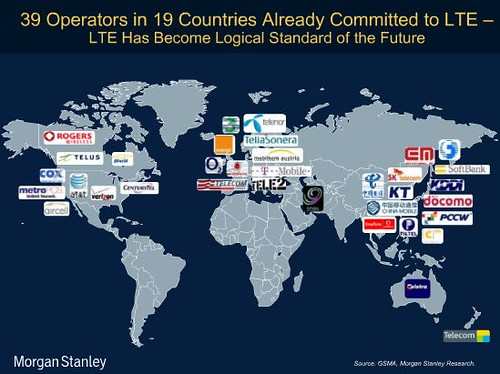The WiMax Forum is celebrating it’s 10th anniversary today. In June of 2001, technology corporations and service providers formed the WiMAX Forum. It had three primary goals in mind: establish standards that ensured interoperability; work with government agencies to release spectrum; and establish and grow an ecosystem to encourage mass adoption of WiMAX™ technologies.
Two out of three isn’t bad.
Intel is given lots of credit (and blame) for WiMAX, but it was Roger Marks who lead the IEEE 802.16 working group which was established by IEEE Standards Board in 1999.
 Roger Marks founded the IEEE 802.16 Working Group in 1998, and has chaired the 802.16 committee ever since.
Roger Marks founded the IEEE 802.16 Working Group in 1998, and has chaired the 802.16 committee ever since.
It completed the first WirelessMAN air interface standard in 2001 (for use above 10 GHz), and approved 802.16a, the original Wi-Max spec, in January, 2003.
It was followed by the 802.16d (fixed) standard in 2004, which consolidated the previous standards and added MIMO support.
In December 2005, the mobile spec was approved (802.16e).
The goal of WiMAX was to extend WiFi-like service to an entire community. It would use inexpensive components and utilize licensed or unlicensed frequencies.
The key to WiFi’s success was a simple Time Division Duplex protocol and flat IP architecture. A basestation could be plugged into a DSL line. Simple. Cheap. WiMAX combined WiFi speed and simplicity with cellular range. It uses the (licensed) 2.3 Ghz, 2.5 Ghz and 3.5 Ghz as well as the unlicensed 5.8 Ghz and 3.65 GHz bands. It plugs into Ethernet – like WiFi. It supports roaming voice and high speed data – like cellular.
The IEEE used every trick in the book for Mobile WiMAX. The number of subcarriers in Scaleable OFDM could be adjusted dynamically. For weaker indoor reception, a Mobile WiMax client uses fewer (but stronger) subcarriers with rugged QPSK modulation.
With subchannelization, MIMO antennas and beam forming, coverage increased from 2km to 9km, a twenty-fold increase in coverage and subscribers. It wasn’t perfect. The Scalable OFDM carrier of Mobile WiMAX “broke” compatibility with fixed 802.16-2004, but it gained global acceptance. The WiMAX Forum formed to promote the standard and monitor interoperability between vendors.
Lucent, Ericsson and Nokia were dismissive. Their vendor specific, turnkey solutions for cellular carriers required lots of proprietary gear. But HSDPA could only fit about ten customers per segment, or 30 per base station. Mobile WiMax – in many ways just a glorified access point – could easily double the data rate and subscriber count – at a quarter the cost, claimed its supporters.
WiMAX was WiFi on steroids. All it needed was spectrum.
Today, IEEE 802.16m-2011 specifies the WirelessMAN Advanced — the first true ITU approved 4G standard with 100 Mbps mobile speeds. It was published by IEEE on 6 May, 2011, following approval on 31 March by the IEEE-SA Standards Board.
Samsung and Yota are testing Mobile WiMAX 2.0 (IEEE 802.16m) right now. By using 4X2 MIMO in an urban microcell, and 20 MHz TDD channels (double the usual 10 MHz), the 802.16m system can support both a 120 Mbit/s downlink and 60 Mbit/s uplink per site simultaneously, says the WiMAX Forum.
The LTE-Advanced camp may follow closely behind, with 100 Mbps upgrades to the current “4G” standards as early as mid-decade.
After WiMAX 2 and LTE, using 4×2 MIMO antennas (4 transmit, 2 receive), as many as 8 transmit antennas are expected to be utilized for beamforming. That would enable longer reach, more capacity, and interference reduction.
Ten years ago, I thought that Best Buy would be selling unlicensed 5.8 GHz WiMAX access points for $200 and that it would enable a grass-roots telecommunication revolution. I was mistaken. Instead, WiFi has held down the fort on the home front, in the unlicensed 2.4, 5 GHz and 60 GHz bands.
WiMax also lost out to Long Term Evolution as the dominant cellular broadband standard globally. But WiMAX will survive as a “niche” technology, said industry observers.
It’s a pretty good niche. WiMAX can run on licensed and unlicensed frequencies, it utilizes spectrum efficiently using Time Division multiplex on a single channel (like WiFi), as well as paired frequencies using Frequency Division (like cellular), and it is an open and inexpensive system with a broad base of vendors and users.
Maravedis Research recently announced that at the end of Q1 2011 there were 17.25 million WiMAX subscribers globally. Not exactly setting the world on fire.
But the accomplishments of the IEEE 802.16 standards groups and the WiMAX Forum, which tests compatibility between vendors, cannot be denied. They have given us a world-wide broadband wireless standard that works. It’s a remarkable accomplishment and transformative on a planetary scale.
Nobody can predict the future. But one thing seems clear; the dedicated engineers behind these broadband wireless standards have made the world a better place. They have a good reason to celebrate.



















No comments:
Post a Comment